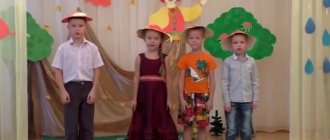Vocal and choral skills as the basis for the development of the singing voice in children
Determine the mode (major, minor) by ear.
3. Diagnosis of harmonic hearing:
Target:
identify the degree of development of harmonic hearing, i.e. ability to determine the number of sounds in intervals and chords.
Musical material: diatonic intervals, major and minor triads.
Diagnostic tasks:
The teacher performs 2-3 consonances (interval, triad, chord) and then asks the child to guess how many sounds are “hidden” in it, and also determine how the consonance sounds: happy or sad.
Diagnosis of the sense of rhythm:
Goal: to identify the level of development of the sense of rhythm.
Musical material: learned songs, rhythmic scores of both mastered and unfamiliar works, consisting of completed durations, rhythmic patterns, groups.
Diagnostic tasks:
Sing a song and at the same time clap your hands in its metrical pattern, then you are asked to clap with your palms alone.
Use clapping to reproduce the proposed rhythmic score with the previously covered rhythmic figures.
Movements to music (walking, running, basic dance movements).
Conduct using basic conducting gestures (inhale, hold, start singing, direct grid, release) a familiar melody in 2/4 or ¾ time for advanced groups), as well as improvised hand gestures to the music.
High level - (score 3): the child’s creative activity, independence, initiative; quick comprehension of a task, accurate and expressive execution of it without the help of an adult, when the child accurately completes the proposed task without errors.
Average level - (score 2): emotional responsiveness, interest, desire to get involved in musical activities. However, the child finds it difficult to complete the task. Requires teacher help, additional explanation, demonstration, repetitions. The child understands that he is mistaken and corrects his mistake.
Low level - (score 1): low emotional; “even”, has a calm attitude towards music, musical activity, no active interest. He is not capable of independence, very rarely performs a task correctly, in most cases he makes mistakes and does not see his mistake and cannot correct it.
At the second stage of the experimental work, a program was built and tested for the formation of vocal and choral skills in children of primary school age in choir lessons, developed on the basis of D.E. Ogorodnov’s “Methods of comprehensive musical and singing education.”
“Methodology of comprehensive musical and singing education” D.E. Ogorodnova is a scientific work that perfectly corresponds to the spirit of our time. This technique can be called the musician's code. The starting points of his methodology involve the use of all internal resources of different aspects of children’s abilities in their interaction, which is greatly facilitated by the system of recording vocal-modal exercises. The recording allows you to clearly and clearly express the child’s actions when performing a vocal exercise and, thus, “algorithm” the process of developing basic vocal skills. As a result, all aspects of music education can be combined into a single pedagogical process, thereby implementing one of the most important principles of pedagogy - the principle of comprehensive education. A song is learned much faster and remembered better when “when working on the vocal side, many and varied “levers” are put into action: emotionality, imagination, consciousness, not to mention the main thing - the correct and full functioning of the vocal apparatus.” [23]






